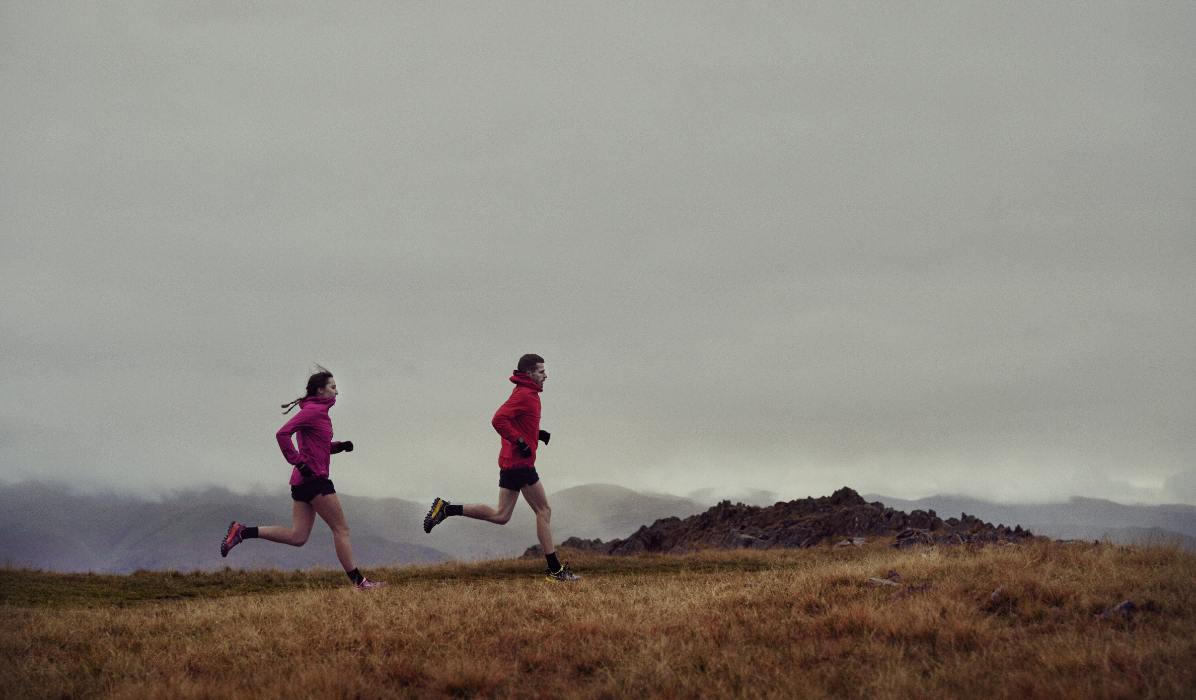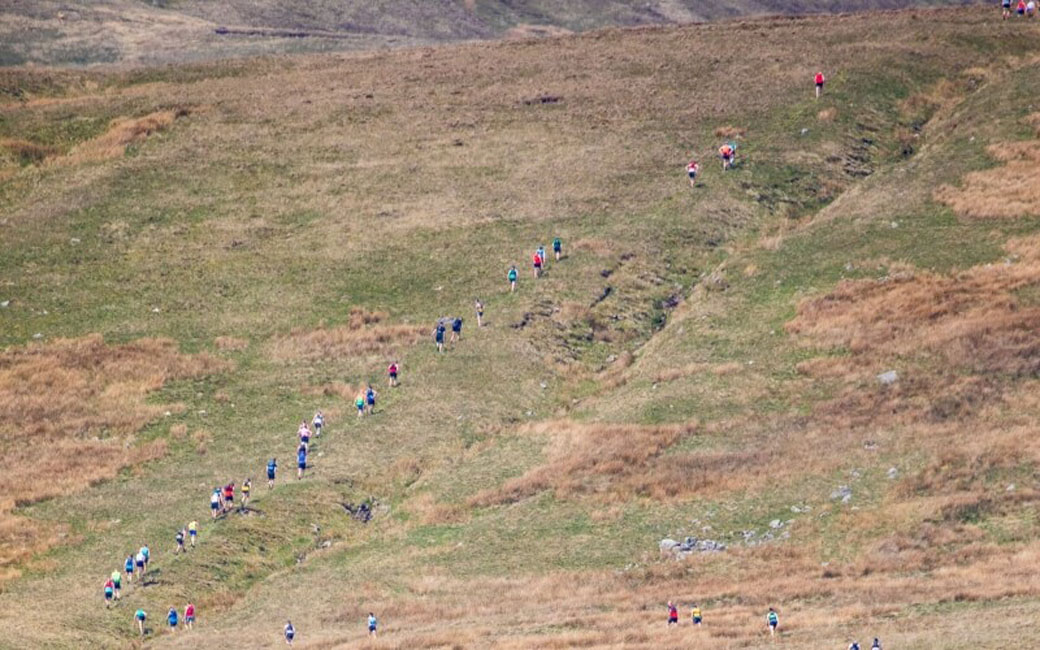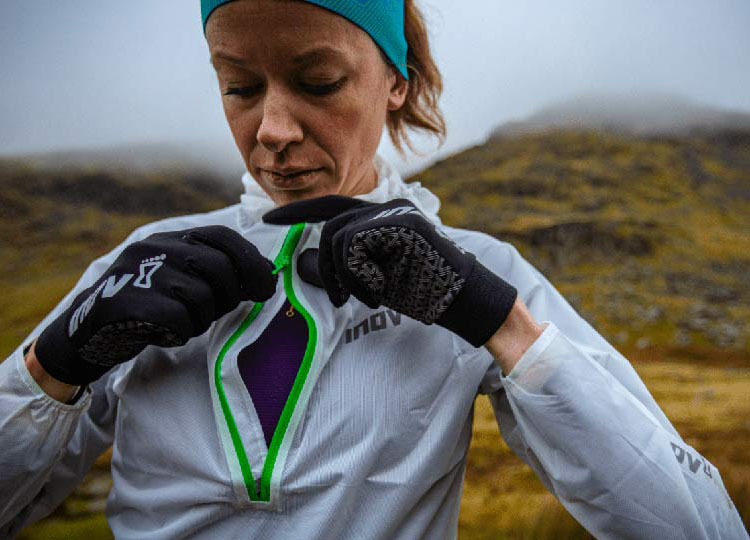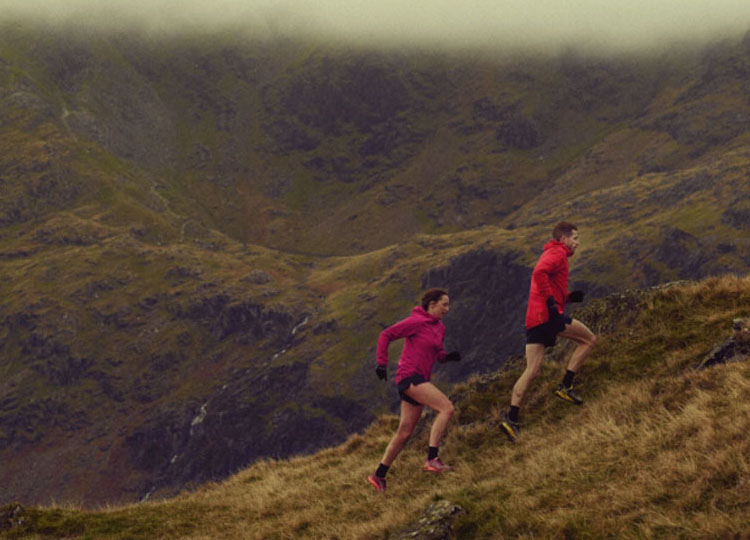
Fell running has it all. Expect lung-busting climbs and quad-shattering descents, all the while trying to navigate terrain with vague or non-existent paths. Brilliant fun!
But how do you train for a fell race? We've asked experienced fell runner, international athlete and top running coach Sarah McCormack to put together a 12-week fell running plan, for a runner looking to take part in a medium-distance fell running race (10k-20k / 6-12 miles).
The training plan should deliver you to the start line of your target race with the strength and confidence to do yourself justice. However, the training plan itself is just one aspect of fell racing - be sure to also read our top tips for fell runners, as well as our pointers on uphill/downhill running technique.
You'll notice that the plan is not for a complete beginner. You should modify or not use the plan if the sessions and mileage would be a significant jump in what you're currently used to.
We hope that you find the training plan useful. Be strong. Be brave. Get muddy!
WHAT IS FELL RUNNING?
Fell running is a type of off-road running on hilly terrain of various degrees of difficulty. Many fell runners also take part in organised fell running races or undertake fell running challenges.
In contrast to trail running races, fell races are often not run on footpaths or trails, but rely on competitors finding a 'racing line' to get point to point in the most efficient way possible.
The word 'fell' refers to a hill or high ground that is often barren or moor covered. In some countries fell running is called hill running (Scotland), or mountain running (Rest of World). The sport of fell running began in the 19th century in the English Lake District, though the first recorded hill running race took place in Scotland in about 1040. Today, fell/hill running races take place throughout the UK, with a big calendar of events filling very month.
The price to enter fell running races can vary, some are even free! Most charge a small amount that covers the costs of staging the race. The atmosphere at most fell races is family friendly, with some also having junior races across several age categories.
HOW ARE FELL RACES GRADED?
In England, fell running is governed by the Fell Runners Association (FRA). Most fell races are graded using two letters: one to denote the difficulty of the ascent, the other to represent the distance of the race.
Ascent Categorisation
Fell races fall into three ascent categories, labelled A, B and C. These are determined by the minimum amount of climb the race averages per kilometre, and a maximum percentage of distance of the race distance that's on road.
| Category | Minimum Climb Per Kilometre | Maximum % Of Distance On Road |
| A | 50m | 20% |
| B | 25m | 30% |
| C | 20m | 40% |
Distance Categorisation
The second category is for the race distance itself, graded as short, medium or long (S, M or L).
| Category | Distance |
| S | 10K or less |
| M | 10-20K |
| L | 20K or over |
The two letters are then combined to give a race grading. This training plan has been written for someone who wants to tackle an AM fell race - so that's a 10-20K race, which has a minimum 50m of climb per kilometre, and a maximum of 20% of the race distance on road.


SARAH MCCORMACK'S FELL RUNNING TRAINING PLAN FOR A MEDIUM-DISTANCE RACE
It's important you read the training guidelines in conjunction with this program, as it explains the sessions in more depth. It's also worth reading the section on working out your effort levels too, particularly where the plan talks about running sessions at different race paces.
| Week | Mon | Tues | Weds | Thurs | Fri | Sat | Sun |
1 | 60 mins flat, easy run (can be done on road or trail) | Hill reps: 6 x 1 min very hard uphill/3 mins easy downhill & flat recovery jog. Aim for fastest sustainable pace for the uphill sections | 60 mins easy run on fell or trail | Rest | 50 mins flat, easy run (can be done on road or trail) | *Tempo: 25 mins cruising fell tempo @ 3h race pace (65-70% effort). Aim to include a sustained 10-15 mins climb during your session | 2h easy fell run |
| 2 | 50 mins flat, easy run (can be done on road or trail) | Hill reps: 6 x 1 min hard uphill, then easy jog back to your starting point. Followed by 3 mins jog, then 6 x 30s hard uphill, easy jog back to starting point. Aim for fastest sustainable pace for the uphill sections | 60 mins easy run on fell or trail | Rest | 50 mins flat, easy run (can be done on road or trail) | *Tempo: 30 mins cruising fell tempo @ 3h race pace (65-70% effort). Aim to include a sustained 10-15 mins climb during your session | 2h easy fell run |
| 3 | 40 mins flat, easy run (can be done on road or trail) | Trail fartlek: 6 x 3 mins with 90s easy jog recovery. Aim for 1h race pace (90% effort) for the reps | 60 mins easy run on fell or trail | Rest | 40 mins flat, easy run (can be done on road or trail) | Continuous uphill reps: 10 x 1 min hard uphill/1 min easy uphill. Run on a steep but run-able incline. Aim for your fastest sustainable pace | 2h easy fell run |
| 4 | 40 mins flat, easy run (can be done on road or trail) | *Continuous uphill reps: 5 x 3 mins hard uphill/2 mins easy uphill run on a gradual incline Aim for 1h race pace (90% effort) for your 3 minute reps | 60 mins easy run on fell or trail | Rest | 40 mins flat, easy run (can be done on road or trail) | Hill loops: 4 x 6 mins - 4 reps of a hill that takes 3.5-4 mins to climb and 2-2.5 mins to descend. Aim for 1h race pace on the climbs (90% effort) and a slightly more relaxed 2h race pace (80% effort) on the descents | 1.5h easy fell run |
| 5 | 60 mins flat, easy run (can be done on road or trail) | Trail fartlek: 5 x 4 mins fast with 2 mins easy jog in between reps. Aim for 1h race pace (90% effort) for your 4 minute reps | 60 mins easy run on fell or trail | Rest | 50 mins flat, easy run (can be done on road or trail) | Hill reps: 2-4-2-4-2 mins hard uphill with a jog-back-to-start recovery, on a steep but run-able climb. Aim to run the uphill efforts at your fastest sustainable pace | 2.5h easy fell run |
| 6 | 60 mins flat, easy run (can be done on road or trail) | Up & down hill reps: 3 x 6 mins. Using a small hill that takes you 60-90s to summit, run up and down at hard intensity for 6 mins. Take a 3 mins recovery between each rep | 60 mins easy run on fell or trail | Rest | 50 mins flat, easy run (can be done on road or trail) | *Uphill tempo: 20 mins tempo effort @ 1h race pace (90% effort) on a continuous climb | 2h easy fell run |
| 7 | 50 mins flat, easy run (can be done on road or trail) | Trail fartlek: 5 x 5 mins fast with 2 mins easy jog in between reps. Aim for 1h race pace (90% effort) for your 5 minute reps | 40 mins easy run on trail | Rest | 40 mins flat, easy run (can be done on road or trail) with 4 x 10s strides | Short fell race (4-6 miles) | 1h easy trail run |
| 8 | Rest | 60 mins flat, easy run (can be done on road or trail) | 60 mins easy run on fell or trail | Rest | Rest or x-train | *Fell tempo: 40 mins fell tempo @ 2h race pace (80% effort). Aim to include a sustained 20-25 min climb during the session | 2.5h easy fell run |
| 9 | 60 mins flat, easy run (can be done on road or trail) | Trail fartlek: 8 x 3 mins fast with 90s easy jog in between reps. Aim for 1h race pace (90% effort) for your 3 minute reps | 40 mins easy run on trail | Rest | 30 mins flat, easy run (can be done on road or trail) with 4 x 10s strides | *Medium fell race (7-10 miles) | 1h easy trail run |
| 10 | Rest | 60 mins flat, easy run (can be done on road or trail) | 60 mins easy run on fell or trail | Rest | Rest or x-train | Hill loops: 4 x 8 mins - 4 reps of a hill that takes 5-6 mins to climb and 2-3 mins to descend. Aim for 1h race pace on the climbs (90% effort) and a slightly more relaxed 2h race pace (80% effort) on the descents | 2h easy fell run |
| 11 | 50 mins flat, easy run (can be done on road or trail) | Tempo: 15 mins cruising trail tempo @ 2h pace (80% effort), then 3 mins rest. Follow this with 4 x 2 mins hard uphill/easy run back to starting point. Follow this with a further 10 mins cruising trail tempo @ 2h race pace | 60 mins easy run on fell or trail | Rest | 40 mins flat, easy run (can be done on road or trail) | Hill reps: 4 x 1 min hard uphill, then easy jog back to your starting point. Followed by 3 mins jog, then 4 x 4 mins hard uphill, easy jog back to starting point. Aim for fastest sustainable pace for the uphill sections | 2h easy fell run |
| 12 | 40 mins flat, easy run (can be done on road or trail) | Trail fartlek: 3 x 4 mins fast with 3 mins easy jog in between reps. Aim for 1h race pace (90% effort) for your 4 minute reps | 40 mins easy run on trail | Rest | 30 mins flat, easy run (can be done on road or trail) with 4 x 10s strides | Goal race | 1h easy trail run |
*Runs marked in bold are good opportunities to test your race day fuelling strategy.


ABOUT SARAH
Sarah McCormack is an athlete, running coach and INOV8 ambassador. Based in the Lake District, Sarah is an accomplished fell, cross country and mountain runner. Her victories include:
- Irish Cross-Country Champion (2014)
- Three Peaks Fell Race Winner (2022)
- 3x winner of the Snowdon International Mountain Race (2014, 2015 and 2019)
- Mountain Running World Cup Winner (2019).
Sarah uses her wide-ranging running experience to coach and develop other athletes, designing individual training plans to help them achieve their goals. Visit her website, Missing Link Coaching, for more information.
TRAINING PLAN GUIDELINES
For structured sessions, warm up for 10-15 minutes before (including 4 x 10s strides) and warm down for 10-15 minutes after. Structured sessions are tempo runs, fartleks, hill reps, progression runs, and runs with surges.
Fartleks
Aim for a hard 90% effort for your reps - but not flat out (90% effort is approximately your one-hour race pace). Your fartleks can be done on firm, rolling trail, or on grass in a park.
Surges and strides
These are not sprints! They are fast 10-30 second accelerations that are great in a warm-up for a session/race, or as a way of including a little bit of leg speed training at the end of your easy run. They should be nice and quick, but not flat-out sprints. Aim around 80-90 % of your top speed, so you get the benefits of spinning the legs quickly without any fatigue or muscle soreness.
Tempo runs
Most of these should be done at a steady 80% effort, which is approximately two-hour race pace.
Hill reps
You should run these reps at your fastest sustainable pace (but aim for consistent pacing).
If you only have a small hill to work with, it's fine to improvise. You could:
- Run back down again when you reach the top, then go up again, until you accumulate the total amount of uphill running time.
- Start with a flat run into your hill. For instance, if the plan specifies a 4-min uphill rep, but you only have a 2-min hill, you'd run 2 mins hard on the flat then straight into 2 mins hard uphill.
- Use a treadmill with an incline function.
When running hills, you should aim to work on your technique too. Our blog “10 Essential Tips For Running Up And Down Hills” is packed with useful information to help you make short work of challenging climbs and technical descents.


WORKING OUT YOUR EFFORT LEVELS
Understanding your effort level is a key skill in being able to pace and execute a successful fell race. Gauging your effort levels during your fartlek, tempo and progression runs will help you get a really good sense of pacing... even if it takes a little bit of trial and error!
1-hour race pace
- Feels like a controlled hard effort, but not working quite at your limit. The pace will feel difficult to sustain and you'll be looking forward to the rep being over!
- You should only be able to say a few words at a time.
- Maintaining this pace will feel like you are working at 90 % effort, closer to 95 % towards the end of the session.
2-hour race pace
- Feels like a moderately hard effort, but that you're keeping something in reserve.
- You might be able to say 1-2 sentences at a time, but will have to pause between words frequently to breathe.
- Maintaining this pace will feel like you are working at 80 % effort, closer to 85 % by the end of the session.
Easy runs
- By contrast, easy runs should be very relaxed and within your comfort zone.
- You should be able to have a full conversation and not need to pause for breath in the middle of a sentence.
- If you're running in hilly terrain, it may be necessary to incorporate some hiking on the steep sections, to ensure that your effort level doesn't shoot up.
- In general, easy runs should feel like 30-40 % effort.
PERFECTING UPHILL & DOWNHILL RUNNING TECHNIQUE
You may have noticed a fair amount of hill work in the training plan! But while it may be obvious that to race well on the fells you need to run hills, what may be less obvious is that you also need to work on technique.
Good technique when running uphill or descending can shave minutes off even a short fell race. Check out our blog “10 Essential Tips For Running Up & Down Hills” for more information.
TOP 7 TIPS FOR FELL RUNNERS
Invest in a good pair of shoes
It goes without saying that a decent pair of running shoes is a must for fell racing. Good fell running shoes will fit snugly, drain well, and offer strong grip and traction. Our MUDTALON SPEED and MUDTALONare good choices here. Both have 8mm rubber studs that help keep you upright on event the steepest of gradients. The SPEED is lighter and rides closer to the ground, while its sibling has more cushioning for longer runs.If your race will contain larger sections of road/hard surfaces, you may want a shoe with smaller 6mm studs such as the TRAILTALONRecce the route
You've put in the hard hills in training, so you don't want to be let down on the day by taking a wrong turn or a long detour. Running the route at least once before your goal race is really helpful to help you get familiar with the course and the best racing lines. You may want to zone in on tricky sections and practice running them a few times as part of your prep.Check the kit list and be prepared to carry it
The Fell Runners Association has a mandatory minimum kit list, but your race organiser may require you to carry more than this depending on the course and the conditions. Not carrying the required kit can be dangerous and will lead to disqualification from the race. For an AM fell race you should expect to carry as a minimum: waterproof jacket with hood, waterproof trousers, hat, gloves, map, compass, whistle and emergency food. Most people tend to carry this kit in a waist pack, or possibly a race vest on a longer race/warmer day.Plan 1-2 preparation races before your goal race
The training plan suggests two weekends for preparation fell races. These are great opportunities to test out your race-day routine, shoes, pacing, fuelling, etc. - if it goes wrong, it's not the main event! If the dates in the plan don't quite work for you, it's fine to move these to another weekend as needed. However, we'd advise not doing a medium-distance fell race the weekend before your goal race.Practice your fuelling strategy
For longer fell races it can be advantageous to bring gels or chews to take during your race. In an AM graded fell race 2-3 gels is probably sufficient for most people. With this in mind you should aim to practice taking on fuel during your runs. In the plan the runs marked in bold offer a good opportunity for practicing. On these days try to go through your full race day fuelling routine - including your pre-race breakfast, taking on 1-2 gels before your run, and taking on fuel/drinks during your session.Learn to navigate
Whether racing or not, if you're running in the hills, it's essential that you know how to navigate. This will not only keep you safe, but also help you to be a faster fell runner. The Fell Runners Association offers navigation courses in the Lake District and Yorkshire Dales. If these aren't convenient for you the Fell Running Guide offers courses in the Peak District. In Scotland Trail Running Scotland offers courses in Aviemore and the Pentland Hills, and Girls On Hills run courses in Glencoe and the Cairngorms.Don't neglect strength and conditioning
Strength is crucial to fell running. The demands of running/walking uphill and the forces exerted on steep descents can be considerable. By supplementing your running training with strength training, you can run stronger on the fells and reduce your risk of injury. Check out our blog “6 Essential Strength Exercises For Trail Runners” as a starting point for your strength routine.
SOME GREAT MEDIUM DISTANCE FELL RACES TO TRY
These are some of our picks of AM fell races. You can find a full list of events on The Fell Runners Association website.
Loughrigg Silverhow Fell Race, Lake District
Taking part in early February, Loughrigg Silverhow is on the shorter side at 8.5 miles long. But don't let the short distance fool you - there's still 880 metres of climbing to be done! That said, Loughrigg Silverhow is a good choice for people newer to fell running due to its shorter distance and out and back course.Fairfield Horseshoe Fell Race, Lake District
Dating back to 1966, this beautiful, 9-mile fell race is one of the oldest fell races in the Lake District. Normally run in mid-March, the race has just over 900 metres of ascent.Long Mynd Valleys Fell Race, West Midlands
Run in February, the 11.5 mile Long Mynd Valleys fell race includes a whopping 1,360 metres of ascent.Ingleborough Mountain Race, Yorkshire Dales
6.8 miles and 600 metres of ascent, the Ingleborough Mountain Race is normally run in July.Bleaklow Blitz Fell Race, Peak District
With fantastic views of the Longdendale Valley, the Bleaklow Blitz is an 8 mile fell race with 450 metres of climb.Ras yr Aran Fell Race, Snowdonia
This 10 mile fell race is run on a mixture of well-marked trail and unmarked fell. Includes nearly 950 metres of climb.Ben Lomond Hill Race, Loch Lomond
Starting and finishing on the banks of Loch Lomond, run to the summit of Ben Lomond and then back down again. The race covers 7.8 miles and includes 960 metres of ascent.Durisdeer Hill Race, Dumfriesshire
Usually in June, the Durisdeer Hill race is run over 10 miles and includes 1,200 metres of climb.
